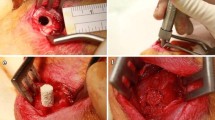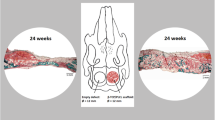Abstract
Radiographic and densitometric evaluation of a new type of bone graft substitute derived from reef-building sea coral via a hydrothermal chemical exchange process was undertaken in a canine diaphyseal defect model. Comparably sized blocks of this material and autogenous iliac cortical-cancellous graft were implanted into the respective radial diaphyses of seven dogs. Qualitative and quantitative radiographic assessment was performed during the immediate postoperative period and at 3 months following surgery. Significant complications were observed radiographically in over half of the coralline implanted limbs, including failed union, graft fracture, and loosening of internal fixation hardware. No significant difference was noted in degree of native osseous ingrowth between the implants and the autografts, and the latter exhibited a higher success rate. Radiographic film densitometry was found not to be reliably predictive of coralline implant behavior in the individual case. It is concluded that coralline hydroxyapatite bone graft substitutes appear to offer no particular advantage over autogenous grafts in the management of diaphyseal defects, although further investigation is warranted since other factors may be responsible for the unfavorable findings in this study.
Similar content being viewed by others
References
Bajpai PK (1983) Biodegradable scaffolds in orthopaedic, oral, and maxillofacial surgery. In: Rubin LR (ed) Biomaterials in reconstructive surgery. CV Mosby, St. Louis p 312
Chiroff RT, White EW, Weber JN, Roy DM (1975) Tissue ingrowth of replamineform implants. J Biomed Mater Res 6:29
Dawson EG, Dutton RO, Dickstein HL (1982) The fate of bone substitution with porous hydroxyapatite implants in the dog spine. Orthop Trans 6:25
Dunn EJ, White EW (1976) Bone ingrowth in replamineform porous implants. In: Williams D (ed) Biocompatibility of implant materials. Pitman Medical Publishers, Kent, p 80
Eysel W, Roy DM (1975) Topotactic reaction of aragonite to hydroxyapatite. Z Kristallogr 141:11
Finn RA, Bell WH, Brammer JA (1980) Interpositional “grafting” with autogenous bone and coralline hydroxyapatite. J Maxillofac Surg 8:217
Holmes RE (1979) Bone regeneration with a coralline hydroxyapatite implant. Plast Reconstr Surg 63:626
Holmes RE, Salyer KE (1978) Bone regeneration in a coralline hydroxyapatite implant. Surg Forum 24:611
Holmes RE, Mooney V, Bucholz R, Tencer A (1984) A coralline hydroxyapatite bone graft substitute. Preliminary report. Clin Orthop 188:252
Holmes RE Bucholz RW, Mooney V (1986) Porous hydroxyapatite as a bone graft substitute in metaphyseal defects: a histometric study. J Bone Joint Surg 68A:904
Jarcho M (1981) Calcium phosphate ceramics as hard tissue prosthetics. Clin Orthop 157:259
Mooney V, Holmes R (1982) A new bone graft substitute. In: Uhthoff HK (ed) Current concepts of external fixation of fractures. Springer, Berlin, p 425
Patel A, Honnart F, Guillemin G, Patat JL (1980) Use of madreporaria coral skeletal fragments in orthopaedic and reconstructive surgery: experimental studies and human clinical application. Chirurgie 106:199
Piecuch JF, Topazian RG (1982) Results of experimental ridge augmentation with porous hydroxyapatite implants: a preliminary report. Acta Stomatol Int 3:67
Piecuch JF, Topazian RG, Skoly S, Wolfe S (1983) Experimental ridge augmentation with porous hydroxyapatite implants. J Dental Res 62:148
Roy DM, Linnehan SK (1974) Hydroxyapatite formed from coral skeletal carbonate by hydrothermal exchange. Nature 247:220
Sartoris DJ, Gershuni DH, Akeson WH, Holmes RE, Resnick D (1986) Coralline hydroxyapatite bone graft substitutes: preliminary report of radiographic evaluation. Radiology 159:133
Sartoris DJ, Holmes RE, Bucholz RW, Mooney V, Resnick D (1986) Coralline hydroxyapatite bone graft substitutes in a canine metaphyseal defect model: radiographic-histometric correlation. Invest Radiol (in press)
Sartoris DJ, Holmes RE, Tencer AF, Carmichael TW, Mooney V, Resnick D (1986) Coralline hydroxyapatite bone graft substitutes in a canine metaphyseal defect model: radiographic-biomechanical correlation. Skeletal Radiol (in press)
Torgalkar AM (1979) A resonance frequency technique to determine elastic modulus of hydroxyapatite. J Biomed Mater Res 13:907
Weber JN, White EW (1973) Carbonate materials as precursors to new ceramic and polymer materials for biomedical applications. Min Sci Eng 5:151
Weber JN, White EW, Lebiedzik J (1971) New porous biomaterials by replication of echinoderm skeletal microstructures. Nature 233:337
White RA, Weber JN, White EW (1971) Replamineform: a new process for prepating porous ceramic, metal, and polymer prosthetic materials. Science 176:922
White EW, Weber JN, Roy DM, Owen EL, Chiroff RT, White RA (1975) Replamineform porous biomaterials for hard tissue implant applications. J Biomed Mater Res Symp 6:23
White RA, White EW, Nelson RJ (1979) Uniform microporous biomaterials prepared by the replamineform technique. Biomater Med Devices Artif Organs 7:127
White RA, Shors E, White EW (1981) Uniform microporous biomaterials prepared from marine skeletal precursors. Proc Int Coral Reef Symp 2:95
Author information
Authors and Affiliations
Rights and permissions
About this article
Cite this article
Sartoris, D.J., Holmes, R.E., Bucholz, R.W. et al. Coralline hydroxyapatite bone graft substitutes in a canine diaphyseal defect model: radiographic features of failed and successful union. Skeletal Radiol 15, 642–647 (1986). https://doi.org/10.1007/BF00349861
Issue Date:
DOI: https://doi.org/10.1007/BF00349861




